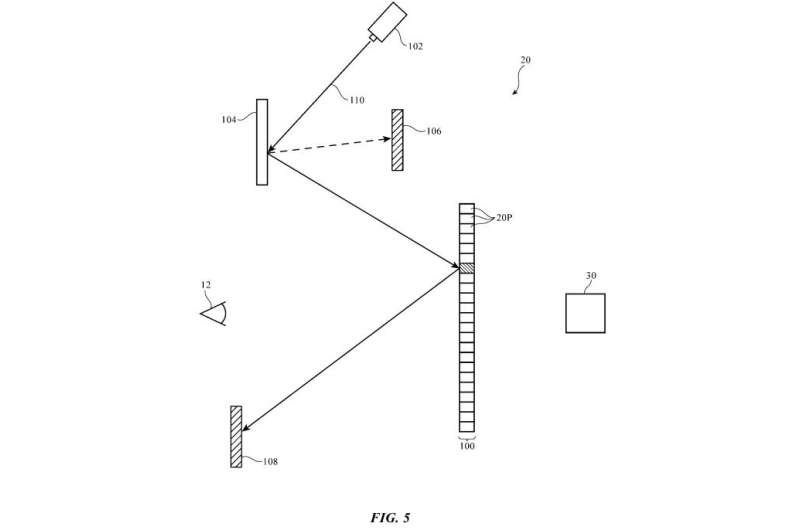November 3, 2019 weblog
Patent talk: Transition lenses in broad daylight for AR

Will they or won't they? Headlines surface regularly that this, that or the other among digital brands are going to come out with a killer pair of augmented reality glasses, and it's hope, too, mixed with anticipation, feeding the buzz.
IEEE Spectrum
on Oct. 21 just let the impatience all hang out and asked: "Why don't we have AR glasses for consumers yet?"
ARM's Nandan Nayampally had an answer: "It's an application that has very high performance requirements but with a lot of constraints, so many key technology pieces had to be right. For example, it requires very high levels of specialized computation that fit within certain envelopes of power and size."
Now that is all the more reason to be even curioser and curioser about the latest patent talk concerning Apple. Tech watchers are saying that the patent application filed with the USPTO titled "Head mounted device with an adjustable opacity system" is about augmented reality glasses with transition lenses.
Yoni Heisler, writing in BGR, found the patent talk to be "the most intriguing Apple rumor of late."
Three California-based inventors are named, David Kalinowski, Hyungryul Choi and Jae Hwang Lee. The patent filing was made public on Oct. 24. A note on the application read "This application claims the benefit of provisional patent application No. 62/662,099, filed Apr. 24, 2018, which is hereby incorporated by reference herein in its entirety."
Christian de Looper in Digital Trends said the device may end up being able to adjust how opaque the lenses are. If so, then it solves a big problem, for "when you're in a brightly lit environment, it can be hard to see the image being projected over the top of your environment."
Heisler likewise could see the rationale for pushing something like this: "it would seemingly be hard to make out information displayed on a regular pair of lenses in broad daylight. Transition lenses would address this problem rather simply."
Plain and simple, projected images, said Gizmodo, can be hard to read in brightly lit areas.
The Background section of the patent application reads: "Head-mounted displays may be used to display virtual reality and augmented reality content. A head-mounted display that is displaying augmented reality content may overlay computer-generated images on real-world objects. If care is not taken, the computer-generated images may be difficult to see against the real-world objects, real-world objects may distract a viewer, or other issues may arise with displayed content."
What would they look like? Digital Trends: "Many are hoping that the glasses will look like a normal pair of glasses that house smart tech inside the frame, but that will depend on whether or not Apple has been able to miniaturize the tech required for augmented reality glasses."
Here is what the patent abstract had to say about its proposed head-mounted device:
"The transparent display may be formed from a display unit that provides images to a user through an optical coupler. A user may view real-world objects through the optical coupler while control circuitry directs the transparent display to display computer-generated content over selected portions of the real-world objects. The head-mounted display may also include an adjustable opacity system.
"The adjustable opacity system may include an adjustable opacity layer such as a photochromic layer that overlaps the optical coupler and a light source that selectively exposes the adjustable opacity layer to ultraviolet light to control the opacity of the adjustable opacity layer. The adjustable opacity layer may block or dim light from the real-world objects to allow improved contrast when displaying computer-generated content over the real-world objects."
Gizmodo's Victoria Song turned her focus toward the patent's talk of an "adjustable opacity layer." What could they mean? "That layer would be inside the lenses and use ultraviolet light to control the lens' transparency," she wrote. "That could block or dim light to up the contrast between projected images and real-world objects. Basically, Apple is describing something similar to transition lenses."
Max Freeman-Mills in Wareable wrote about the patent filing in his item, "Apple's AR smartglasses might have dimmable lenses." He said the patent talk was about a head mounted display "with adjustable rates of opacity, to help users fine-tune their viewing experience." As needed, the lenses could brighten or darken.
"That's an enticing idea," he remarked...."It could also let you block out your surroundings entirely, if you need to concentrate on a message or some information."
How likely is the talk to develop into product? Before you reply in the negative, chiming in with the standard not-all-patent-ideas-materialize, remember that a research note from Apple analyst Ming-Chi Kuo and discussed in The Verge, said Apple may launch its augmented reality headset for the iPhone in 2020.
© 2019 Science X Network




















